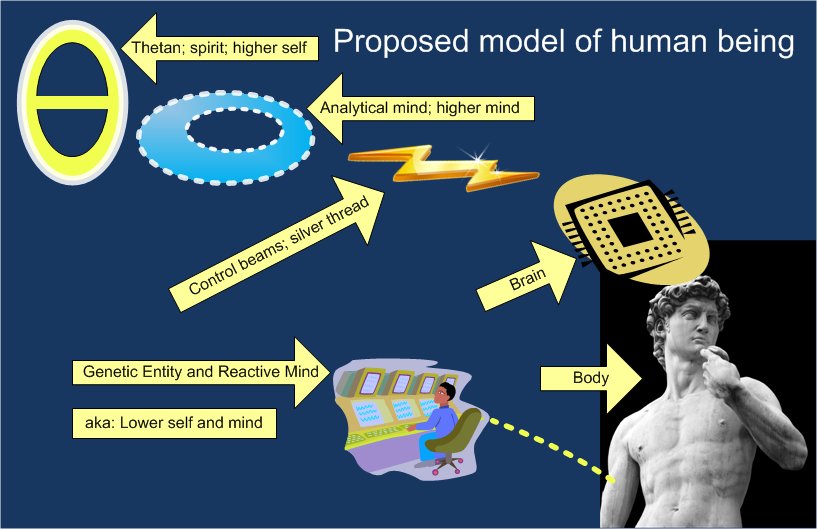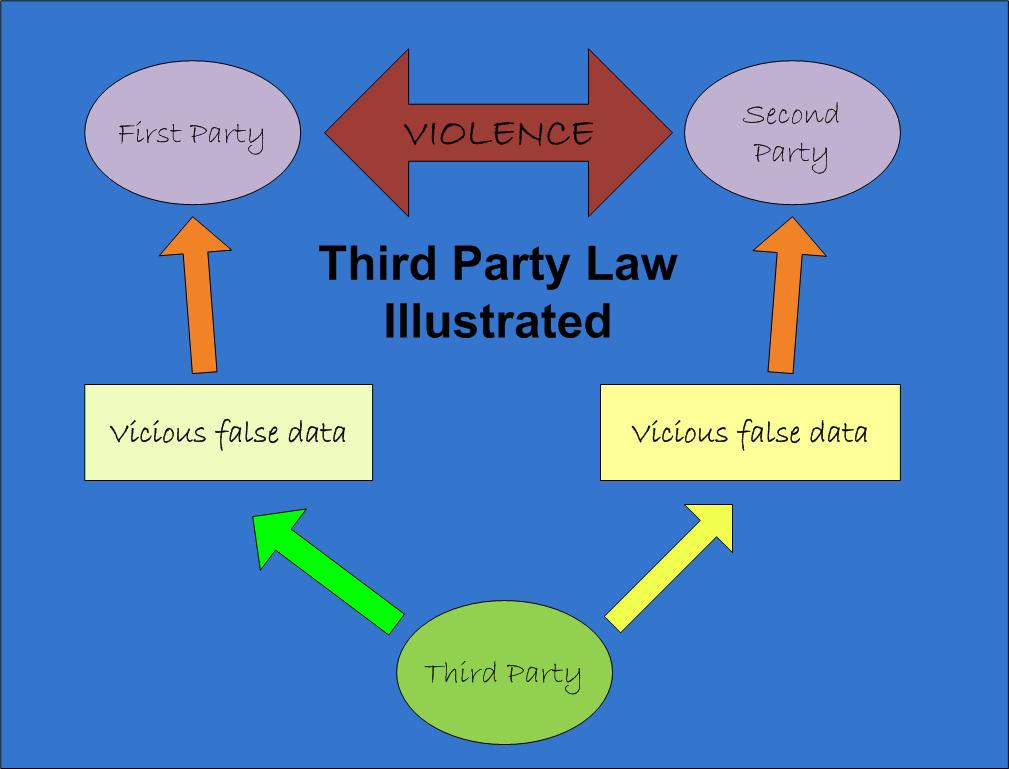Illustrations |
Scientology |
 Figure 3. My illustration for Hubbard's model of an advanced life form.
Figure 3. My illustration for Hubbard's model of an advanced life form.
 Figure 4. My blog illustration for the Third Party Law.
Figure 4. My blog illustration for the Third Party Law.
|
Where I want to start
I want to start with the esoteric. The creation and the creator.
What we call
In Scientology From the Esoteric to the PracticalThe early theory of Scientology has a lot to do with how the spirit handles its relationship with the things it creates, and with other beings in its environment. This material was being developed parallel to the development of improved methods for accessing spiritual memory.
Dianetics theory started earlier. It was based on a set of very practical techniques
for improving the survival potential of the individual. In his first book on the
subject in 1950, Hubbard introduced a numbering system for a person's ability to survive
(or attitude towards survival) which became known as the Tone Scale. The original scale,
which went from zero to four, adequately covered the experience of most people in social
situations. But when Hubbard began to study people as beings, separable from both their bodies
and their minds, a wider range of possible attitudes and abilities opened up, and the scale
was gradiently expanded. The plus 40 to minus 40 scale in Figure 2 is considered This scale traces the full descent of a being from knowing creator down into total unknowingness. Hubbard developed auditing as a way to reverse this process. It has been noticed that people rise and fall on this scale in session and in life, and the scale was based on Hubbard's experiences as an auditor and as an observer of life. Though he has discussed the more esoteric patterns that appear in this scale in various books and lectures, it remains a basic tool for auditors and Scientologists, who see it as something highly practical and not esoteric at all. The best known pre-Scientology book about this scale is called Science of Survival which was written (actually transcribed from dictation) in 1951. In this book - basically a collection of short treatises on the subject - Hubbard shows how a tone level can be assigned to an individual, a group, or a nation, and its future behavior predicted assuming the tone level assessment is accurate.
The scale is also used by an auditor in session to help him judge the progress of a given process.
(When the preclear starts a process, he commonly You may skip ahead here if you wish, while I return to some of the more esoteric ramifications of the defintion of the creator, the creation, and their relationships. We see, then, that one way to look on the Tone Scale is as a measure of the extent to which any given creator (spirit, thetan = θn) is knowledgable of, in control of, taking responsiblity for, and generally comfortable with all that it has created.
Contrary to what one might suppose, Tone 40 is not most beings' favorite spot on the scale.
Most beings tend to really enjoy the Tone 20 area, as long as the experience of
being in action and playing games does not become too overwhelming.
Before the era of solid bodies,
If one had the resources and time, one could theoretically use Hubbard's techniques to reconstruct
the entire history of our universe. Such a history would presumably cover exactly how matter came
to be invented, and then how energy and matter were used to fashion
Assuming the above discussion of our The ModelWhat came out of all this early research was a model (Figure 3) for a human being that LRH used in his training lectures and that Scientologists use to help them understand themselves and others. I wrote about this on my blog (that's where this illustration comes from) so I will not go into
great detail here. But you can see in the above, perhaps, how beings used mechanisms
in the hopes of staying in games that they tended to fall out of. The mind itself was the first
attempt to build something a being could use to carry his mechanisms around with him.
When robots were developed, the idea arose of relegating a lesser being,
or
In such a hierarchy, the truth that we have all been doll body ( The current focus: EthicsHubbard has demonstrated, at least to his own satisfaction, that it is unethical to suppress the truth. In particular, it is unethical to suppress the freedom of the spirit. He found that the truly free being operates at a higher position on the Tone Scale than any other sort of being. That means that not only will the being do better, but so will its family, its friends, it associates, its country, its species, and its planet. Many to this day would agree with this basic observation.
Our Founding Fathers, somehow, recognized this truth and tried to create a nation based on it.
They failed not because they were wrong, but because they were insufficiently skilled at handling
out-ethics. In Scientology we call extreme out-ethics
The more skilled psychpaths have the interesting ability to get higher-toned people
to fight amongst themselves. See Figure 4.
The psychopath's ideal scene (as long as he can protect his status as observer) is for everybody
else to be fighting each other, and supporting him as a Our protection against such beings relies almost entirely on our ability to notice them, understand their behavior, and deal with them without getting pulled downtone by them. However, a certain amount of tone level sag around such beings is inevitable, so it is well worth the trouble and expense involved to sequester such beings, when they are proven to be psychopathic, and to develop ways to rehabilitate them.
|